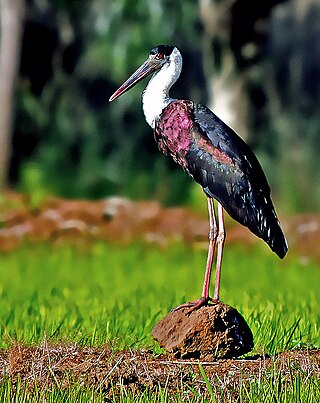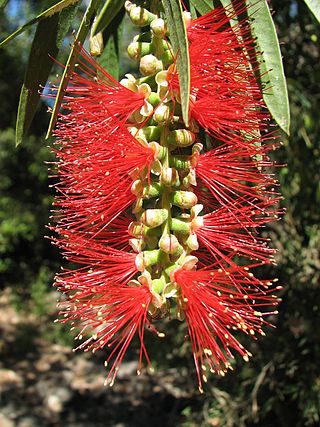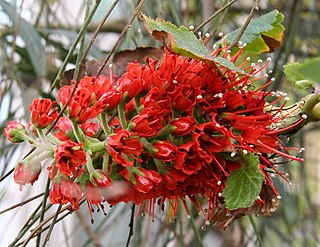
A mammoth is any species of the extinct elephantid genus Mammuthus. The various species of mammoth were commonly equipped with long, curved tusks. They lived from the Pliocene epoch into the Holocene about 4,000 years ago, and various species existed in Africa, Europe, Asia, and North America. Mammoths are more closely related to living Asian elephants than African elephants.

The Asian woolly-necked stork or Asian woollyneck is a species of large wading bird in the stork family Ciconiidae. It breeds singly, or in small loose colonies. It is distributed in a wide variety of habitats including marshes in forests, agricultural areas, and freshwater wetlands across Asia.

Callistemon is a genus of shrubs in the family Myrtaceae, first described as a genus in 1814. The entire genus is endemic to Australia but widely cultivated in many other regions and naturalised in scattered locations. Their status as a separate taxon is in doubt, some authorities accepting that the difference between callistemons and melaleucas is not sufficient for them to be grouped in a separate genus.

Solanum mauritianum is a small tree or shrub native to South America, including Northern Argentina, Southern Brazil, Paraguay and Uruguay. Its common names include earleaf nightshade, woolly nightshade, flannel weed, bugweed, tobacco weed, tobacco bush, wild tobacco and kerosene plant.

The hemlock woolly adelgid, or HWA, is an insect of the order Hemiptera native to East Asia. It feeds by sucking sap from hemlock and spruce trees. In its native range, HWA is not a serious pest because populations are managed by natural predators and parasitoids and by host resistance. In eastern North America it is a destructive pest that threatens the eastern hemlock and the Carolina hemlock. HWA is also found in western North America, where it has likely been present for thousands of years. In western North America, it primarily attacks western hemlock Tsuga heterophylla and has only caused minor damage due to natural predators and host resistance. Accidentally introduced to North America from Japan, HWA was first found in the eastern United States near Richmond, Virginia, in 1951. The pest is now found from northern Georgia to coastal Maine and southwestern Nova Scotia. As of 2015, 90% of the geographic range of eastern hemlock in North America has been affected by HWA.

Beaufortia is a genus of woody shrubs and small trees in the family Myrtaceae and is endemic to Southwest Australia. The genus Beaufortia is closely related to Melaleuca, Calothamnus, Regelia and several others, differing mainly in the way the anthers are attached to the stalks of the stamens, and in the way they open to release their pollen. Beaufortia anthers are attached at one end and open by splitting at the other.

Greyia flanaganii, commonly known as the Kei bottlebrush, is a species of plant in the Francoaceae family. Greyia flanaganii is one of the related species of the taxonomically isolated and endemic southern African family, the Greyiaceae. Greyia flanaganii is endemic to the Eastern Cape Province of South Africa. It is named after Henry George Flanagan, a South African farmer and botanist from Komga, Eastern Cape, South Africa.

Melaleuca viminalis, commonly known as weeping bottlebrush or creek bottlebrush, is a plant in the myrtle family Myrtaceae, and is endemic to New South Wales, Queensland and Western Australia. It is a multi-trunked, large shrub or tree with hard bark, often pendulous foliage and large numbers of bright red bottlebrush flowers in spring and summer. It is possibly the most commonly cultivated melaleuca in gardens and its cultivars are often grown in many countries.

Ludwig Adolph Timotheus Radlkofer, was a Bavarian taxonomist and botanist.

Mimetes hirtus is an upright, evergreen shrub of 1½–2 m (5–6½ ft) high from the family Proteaceae. It has upright, overlapping, (broadly) lance-shaped leaves, without teeth, but with one thickened pointy tip. It has cylindric inflorescences topped by a pine apple-like tuft of pinkish-brownish, smaller and more or less horizontal leaves. The flowerheads are tightly enclosed by yellow, red-tipped bracts, only the 9–14 long red styles and the whitish silky tips of the perianth sticking out. It is primarily pollinated by the Cape sugarbird. It is an endemic species of the southwest of the Western Cape province of South Africa, and grows in wet zones at the base of south facing mountain slopes. Flower heads may be found from May to November, but peaks in July and August. The species has several vernacular names of which marsh pagoda seems to be used most.

Callistemon kenmorrisonii, the Betka bottlebrush, is a shrub in the family Myrtaceae. It is endemic to the state of Victoria in Australia.

Greyia sutherlandii, also known as Natal bottlebrush, is a species of plant in the Francoaceae family. It is native to South Africa, Eswatini, and Lesotho.
Natal bottlebrush is a common name for several plants and may refer to:

Rubus ulmifolius is a species of wild blackberry known by the English common name elmleaf blackberry or thornless blackberry and the Spanish common name zarzamora. It is native to Europe and North Africa, and has also become naturalized in parts of the United States, Australia, and southern South America.

Metalasia muricata, commonly known as white bristle bush or blombos, is a hardy virgate or twiggy shrub with honey-scented flowers usually 2–4 m tall, woody with a rounded crown. It is native to the Cape Provinces of South Africa, where it is an important component of the coastal and mountain fynbos regions. It is encountered in a number of forms in its extended distribution, some of which are tolerant of frost, wind and poor sandy soils.

Arctotheca populifolia is a species of flowering plant in the family Asteraceae known by the common names beach daisy, Cape beach daisy, South African beach daisy, coast capeweed, dune arctotheca, beach pumpkin, sea pumpkin, dune cabbage, and in South Africa, seepampoen, tonteldoek, and strandgousblom. This species is native to coastal areas of the Cape Provinces and KwaZulu-Natal in South Africa, and of Mozambique. It was introduced to Australia and is now a common weed of coastal areas in New South Wales, South Australia, Tasmania, Victoria, and Western Australia.

Aloe rupestris is an arborescent aloe indigenous to summer-rainfall areas of southern Africa.

Melaleuca salicina, commonly known as willow bottlebrush, is a plant in the myrtle family Myrtaceae, and is endemic to eastern Australia. Some Australian state herbaria continue to use the name Callistemon salignus, a name that is accepted by the Australian Plant Census. It is a shrub or small tree with soft foliage, pink new growth, white papery bark and spikes of usually white or creamy bottlebrush flowers in spring.
Henry George Flanagan was a Cape Colony-born plant collector, traveller, botanist and farmer. He developed a renowned garden for native South African trees and rare exotic plants. A rare endemic of Eastern Cape, Greyia flanaganii is one of several plants named in his honour.

Tonteldoos is a village in the province of Limpopo, South Africa. It is located southeast of Roossenekal and 20 km northwest of Dullstroom, between the Steenkampsberg and Mapochsberg mountains. It is part of the Mapoch land seized by poor settlers in 1883 after the Mapoch War against King Nyabêla. Each veteran of the war was granted 8 morgens of the land, while the rest is reserved for communal pasture.
















